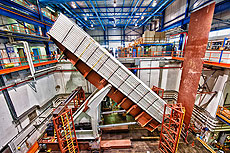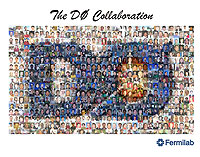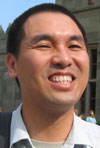|
Thursday, Nov. 17
- Breakfast: Apple sticks
- Southwestern chicken tortilla
- Philly-style cheese steak
- Garlic herb roasted pork*
- Smart cuisine: Mardi Gras jambalaya
- Southwestern turkey wrap*
- Assorted sliced pizza
- Marinated grilled chicken Caesar salads
*carb-restricted alternative
Wilson Hall Cafe Menu
|
|
Friday, Nov. 18
Dinner
Guest Chef: Joe Walding
An English Thanksgiving
- Assortment of canapés: Chicken liver pate, roasted chestnuts, confit goose w/ toast points and onion marmalade
- Roast goose & turkey w/ holiday trimmings
- Variety of desserts, including British Christmas pudding w/ brandy butter
Wednesday, Nov. 23
Lunch
- Cheese fondue
- Marinated vegetable salad
- Peaches w/ blackberry sauce
Chez Leon Menu
Call x3524 to make your reservation. |
|
Pivotal pivoter test paves way
for plastic behemoth
 |
|
Engineers at Fermilab designed and tested a hydraulic system that will move and rotate the huge, 200-ton plastic blocks for the assembly of the NOvA detector. Photo: Reidar Hahn
|
It could be the largest structure ever to be built from plastic. Its footprint of 1,052 square meters will cover an area about the size of a quarter of a football field. Its height will rise past the top of a five-story apartment building. With 368,640 tubes of white PVC, the structure will have about as many components as some of the largest LEGO structures built in the world.
But this huge structure, to be constructed in Ash River, Minn., won’t serve as a plastic replica. It will be the skeleton of a fully functional particle detector. Wired with fiber optic cables and filled with 500 truckloads of mineral oil, the 15,000-ton NOvA detector will enable scientists to discover how the masses of the three types of neutrinos—the lightest, tiniest particles known to mankind—stack up.
Last week, the preparations for the assembly of this white PVC behemoth passed a pivotal test. In an assembly building at Fermilab, 40 miles west of Chicago, scientists, engineers and technicians from Fermilab, Argonne National Laboratory and the University of Minnesota successfully operated for the first time the NOvA pivoter, the hydraulic system developed by Fermilab to move and rotate huge, 200-ton plastic blocks for the assembly of the NOvA detector. (See this 4-minute video with a time lapse of the pivoter test and a fly-through animation of the NOvA detector hall.)
Read more
—Kurt Riesselmann
|
Turkeys and winter driving
A traffic safety seminar will take placefrom 11:30 a.m. to 12:30 p.m. today, in One West. There will be a raffle of various prizes, including a whole turkey, for those in attendance.
|
Annual enrollment information sessions - through Nov. 18
Through Friday, Nov. 18, Fermilab employees have the opportunity to enroll in flexible spending accounts, as well as their medical and dental plans. Any changes made will be effective on Jan. 1, 2012.
Each employee will receive an enrollment packet outlining benefits options. Those currently enrolled in the Blue Cross Blue Shield HMO IL plan will need to enroll in another plan, as this option will no longer be offered. If an employee does not wish to change his or her benefits plan, then he or she does not need to complete an enrollment form.
There will be an information session today at 10 a.m. in the AD-Huddle conference room. The complete list of information sessions is here. For more information, please contact the Benefits Office at x3395.
|
The making and tending of heavy ion beams for the LHC
This week the Large Hadron Collider began heavy ion physics, the process of colliding lead ions to learn about conditions in the primordial universe.
The accelerator is expected to perform five to 10 times better than it did in its first run of these collisions last November. Although the heavy ion program will last only from now until CERN’s annual winter shutdown just after the first week of December, operators started preparations months in advance. Here symmetry breaking examines what it really takes to put lead beams in the LHC.
The source
Making heavy ions is more complicated than preparing the protons used in regular LHC collisions, which come from hydrogen gas. Since hydrogen atoms have only one proton and one electron each, applying a voltage to them is sufficient to rip off their electrons, leaving a load of beam-ready, positively charged protons. But the source for heavy ions, enriched lead, starts with 82 electrons. Physicists do not have miracle flypaper to grab that many subatomic particles at once, so the process takes a few steps.
Read more
|
Violating old rules
From The Economist, Nov. 15, 2011
Physicists are keen on symmetry. The universe does not always humour them. Take the Big Bang: if nature were ideally balanced, equal amounts of matter and antimatter would have emerged from it. If that were true, though, the universe would be a sad and empty place as almost all the primordial particles and antiparticles have cancelled each other out leaving behind nothing but a puff of lifeless, post-annihilation photons. That this did not happen, as is clearly the case, is explained by the fact that things are not, actually, quite symmetrical. Instead, a phenomenon called charge-conjugation/parity violation (or CP violation, for short) let matter gain the upper hand.
If charge conjugation and parity were conserved, nature would not discriminate between particles, on the one hand, and their antiversions, which carry the opposite electric charge and opposite spin, on the other. The Standard Model, the 40-year-old rulebook of particle physics, predicts a smidgen of CP violation, and this has indeed been observed in plenty of experiments since the 1960s.
Read more
|
|
‘All systems go’ in the search for the Higgs boson
 |
| This evidence for diboson production at DZero is an important test of the analysis techniques that are used to search for the Standard Model Higgs Boson.
|
On May 22, 1969, the Apollo 10 Lunar Module dipped to just 47,400 feet above the lunar surface during the “dress rehearsal” for the following mission that landed mankind on the moon two months later. The Apollo 10 mission collected the final data needed to calibrate the lunar module’s guidance systems for a moon landing and successfully tested all other aspects of the following moon-landing mission. A similar dress rehearsal was just completed by the DZero collaboration, but the ultimate goal of our mission is to discover, or rule out the existence of, the Higgs boson.
Below a mass of 135 GeV, a Standard Model Higgs boson would most often decay into a pair of bottom quarks—a difficult signature to pick out from the backgrounds at a hadron collider. To get a handle on the signal in this low-mass region we look for events where a Higgs boson is produced with one of the weak force carriers, a W or Z boson. The decay of that weak force carrier into leptons, in combination with the bottom quarks produced by the Higgs boson, helps flag our signal events. But backgrounds still dominate and we rely on advanced analysis techniques to perform our search. This includes forming a powerful signal discriminant by combining many variables, which individually show only mild separation between signal and background.
We can show that these advanced techniques work by applying the same strategy to look for a Standard Model signal with the same final state as our low-mass Higgs boson search. A Z boson can decay into two bottom quarks, and they can be produced in association with either a W boson or another Z boson. This specific mode of diboson production and decay occurs at roughly four times the rate of the potential Higgs signal. Using the same techniques as in the low-mass Higgs boson search, the DZero Higgs group has just produced the first evidence for this mode of diboson production.
—Mike Cooke
 |
|
This analysis is the result of combined efforts from all of the low-mass Higgs boson search teams at DZero.
|
 |
Kin Yip, Brookhaven National Laboratory, plays an important role in the DZero collaboration’s analysis efforts by organizing the monitoring and support of our data handling and storage systems.
|
|
|